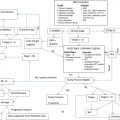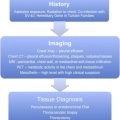Pancreatic cancer (pancreatic adenocarcinoma) remains one of the deadliest malignancies in the western hemisphere despite improved surgical technique, chemotherapy, and radiation therapy. The appropriate management of this malignancy should incorporate multiple treatment modalities for optimal opportunity for cure. Recent trials with a variety of treatment techniques confer improved survival of patients with pancreatic cancer, even in the metastatic setting. In this review, the importance of multidisciplinary management of pancreatic cancer based on disease stage is discussed.
Key points
- •
Multidisciplinary evaluation of patients who have pancreatic cancer may result in a change in the diagnosis and management of patients.
- •
A single-day multidisciplinary clinic is an effective format for approaching this aggressive disease and should involve both physicians and ancillary staff.
- •
Multidisciplinary care should be applied to every stage of this disease, including resectable, borderline resectable, locally advanced, and metastatic disease.
- •
Multidisciplinary care should be implemented in all aspects of management, including diagnosis, initial treatment planning, and follow-up, including reevaluation throughout the course of therapy.
Introduction
Epidemiology
Pancreatic cancer is the fourth leading cause of cancer-related deaths, despite having the 10th most common incidence of all malignancies in the United States. An estimated 43,290 new cases and 37,390 deaths are expected in 2012. The median age of diagnosis in the United States is 72 years, and more than 66% are diagnosed after the age of 65 years. There is a slight predominance in African Americans and Whites as opposed to Hispanics and Asians. Although numerous risk factors have been researched, few have been identified. Cigarette smoking remains the clear modifiable risk factor, whereas chronic pancreatitis and genetic predisposition account for the remaining clear risk factors. Obesity and a Western diet have been implicated as conferring risk, but this is less well understood. The median survival for early-stage disease is 20 to 24 months, with a 5-year survival of only 15% to 20%. Patients with locally advanced disease have a median survival of 9 to 15 months, whereas patients with metastatic disease have a median survival of 4 to 6 months.
Staging
The American Joint Committee on Cancer (AJCC) has been the historical standard for staging of pancreatic cancer. The seventh edition of the TNM (tumor-node-metastasis) staging from the AJCC is shown in Table 1 .
| Stage 0 | Tis | N0 | M0 |
| Stage IA | T1 | N0 | M0 |
| Stage IB | T2 | N0 | M0 |
| Stage IIA | T3 | N0 | M0 |
| Stage IIB | T1 | N1 | M0 |
| T2 | N1 | M0 | |
| T3 | N1 | M0 | |
| Stage III | T4 | Any N | M0 |
| Stage IV | Any T | Any N | M1 |
| Primary Tumor (T) | Regional Lymph Nodes (N) | Distant Metastasis (M) |
|---|---|---|
| Tx: primary tumor cannot be assessed | Nx: regional lymph nodes cannot be assessed | M0: no distant metastasis |
| T0: no evidence of primary tumour | N0: no regional lymph node metastasis | M1: distant metastasis |
| Tis: carcinoma in situ (including PanIN) | N1: regional lymph node metastasis | |
| T1: tumor limited to the pancreas, ≤2 cm in greatest dimension | ||
| T2: tumor limited to the pancreas, >2 cm in greatest dimension | ||
| T3: tumor extends beyond the pancreas but without involvement of the celiac axis or the superior mesenteric artery | ||
| T4: tumor involves the celiac axis or the superior mesenteric artery |
Stay updated, free articles. Join our Telegram channel

Full access? Get Clinical Tree





